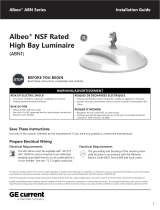
Tetra® Power Supply GEPS24-100U-GLX2 Installation Guide
2
Power Supply Installation
Connect the AC line to the black
or brown (line) and white or
blue (neutral) input wires of the
power supply using suitable wire
connectors.
Connect the supply wire that is
attached to the Tetra LED System
to the red (+) and black or blue (-)
output wires of the power supply
as outlined in the “Electrical
Connections” section of your LED
system’s Installation Instructions.
NOTE: To avoid overloading this
power supply with LED modules,
please refer to the specic module
loading guides.
Input
wires
White or blue
(neutral)
Black or brown
(line)
AC line
To Tetra LED System
Output
wires
Red (+) Black or blue (-)
Mount the power supply. Mounting
the power supply base directly to
a thermally conductive installation
surface can improve thermal
performance.
NOTE: All electrical connections
should be suitably protected
from mechanical damage and the
environment. Seal all connections
exposed to water with electrical
grade self-hardening silicone.
1 2 3
WARNING
RISK OF ELECTRIC SHOCK
AC input connections shall be
suitably enclosed. Optionally,
the GEPSJB60 may be used for
this purpose.
FOR UL ONLY
NOTE: For installation in Canada, a disconnect switch of appropriate rating needs to be placed within 29.5 feet
(9 meters) of primary side of the power supply. The switch voltage rating shall not be less than the branch circuit
voltage. The switch must also support twice the amount of input current.
FOR UL ONLY
NOTE: When installing power supply, connect to the appropriate sized building breaker or disconnect device for line,
neutral and ground connections, in accordance with National Electric Code (NEC) Article 600 and all local regulations.
OPTIONAL
A Weather Box (GEXNWB2) may be used to house and seal Class 2
connections.
A) Insert wire connectors into weather box. Fill with electrical grade
silicone and close box.
B) Secure the weather box using a #6 or #8 (M2 or M3) screw.
Weather box
can be painted
Light engine
A B
WARNING / AVERTISSEMENT
RISK OF ELECTRIC SHOCK
• Disconnect power at fuse box or circuit breaker before servicing
or installing product.
• Properly ground Tetra® power supply.
• AC input connections shall be suitably enclosed. The power supply
shall be enclosed or made inaccessible to users during normal use.
RISK OF FIRE
• Minimum power supply spacing to other power supply or other
heat producing component shall be at least 4” (101.6 mm) from
side to side and 1” (25.4mm) from end to end.
• Use only approved wire for input/output connection. Minimum
size 18 AWG (0.82 mm2).
• Follow all local codes.
• Application considerations potentially requiring additional spacing
include high ambient temperature seen by the power supply, poor
contact with a heat dissipating material, inadequate ventilation, or
direct exposure to sun.
RISQUES DE DÉCHARGES ÉLECTRIQUES
• Coupez l’alimentation électrique à la boîte de fusibles ou au disjoncteur avant
l’entretien ou l’installation du produit.
• Assurez-vous de correctement mettre à terre le bloc d’alimentation Tetra®.
• Les connexions d’entrée CA doivent être convenablement enfermées. Le bloc
d’alimentation doit être enfermée ou rendue inaccessible aux utilisateurs
pendant l’utilisation normale.
RISQUES D’INCENDIE
• L’espacement minimal du bloc d’alimentation par rapport à un autre bloc
d’alimentation ou aux autres composants produisant de la chaleur doit être
au moins 4” (101,6 mm) de chaque côté et 1” (25,4 mm) de bout en bout.
• N’utilisez que des ls approuvés pour les entrées/sorties de connexion.
Taille minimum 18 AWG (0.82 mm2).
• Respectez tous les codes locaux.
• Certaines applications pourraient requérir un espacement additionnel, p.
ex. une température ambiante élevée autour du bloc d’alimentation, un
mauvais contact avec une matière dissipatrice de chaleur, une ventilation
inadéquate ou une exposition directe au soleil.
CAUTION / ATTENTION
RISK INJURY
• While performing installations described, gloves, safety
glasses or goggles should be worn.
RISQUES DE BLESSURE
• Lors de l’exécution des installations décrites, des gants, des lunettes
de sécurité ou des lunettes de protection doivent être portées.






